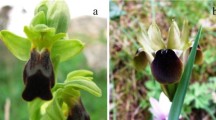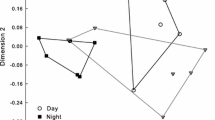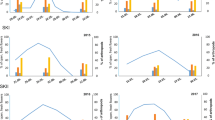Abstract
Larger inflorescences in reward-producing plants can benefit plants by increasing both pollinator attraction and the duration of visits by individual pollinators. However, ultimately, inflorescence size is determined by the balance between the benefits of large inflorescences and the increased cost of geitonogamy. At present, little is known about the relationship between inflorescence size and fecundity in deceptive plants. Given that pollinators are likely to leave inflorescences lacking rewards quickly, it seems unlikely that longer pollinator visits and the risk of geitonogamy would be strong selective pressures in these species, which indicates that pollinator attraction might be the most important factor influencing their inflorescence size. Here we examined the pollination ecology of the deceptive orchid Cephalanthera falcata in order to clarify the effects of inflorescence size on the fruit set of this non-rewarding species. Field observations of the floral visitors showed that C. falcata is pollinated by the andrenid bee Andrena aburana, whilst pollination experiments demonstrated that this orchid species is neither autogamous nor apogamous, but is strongly pollinator dependent. Three consecutive years of field observations revealed that fruit set was positively correlated with the number of flowers per inflorescence. These results provide strong evidence that the nectarless orchid C. falcata benefits from producing larger inflorescences that attract a greater number of innate pollinators. Large inflorescences may have a greater positive effect on fruit set in deceptive plants because a growing number of studies suggest that fruit set in reward-producing plants is usually unaffected by display size.


Similar content being viewed by others
References
Adler LS, Bronstein JL (2004) Attracting antagonists: does floral nectar increase leaf herbivory? Ecology 85:1519–1526
Ågren J, Ehrlén J, Solbreck C (2008) Spatio-temporal variation in fruit production and seed predation in a perennial herb influenced by habitat quality and population size. J Ecol 96:334–345
Arditti J (1992) Fundamentals of orchid biology. Wiley, New York
Ashman T, Knight TM, Steets JA et al (2004) Pollen limitation of plant reproduction: ecological and evolutionary causes and consequences. Ecology 85:2408–2421
Bidartondo MI, Burghardt B, Gebauer G, Bruns TD, Read DJ (2004) Changing partners in the dark: isotopic and molecular evidence of ectomycorrhizal liaisons between forest orchids and trees. Proc R Soc B 271:1799–1806
Biernaskie JM, Walker SC, Gegear RJ (2009) Bumblebees learn to forage like Bayesians. Am Nat 174:413–423
Brody AK, Mitchell RJ (1997) Effects of experimental manipulation of inflorescence size on pollination and pre-dispersal seed predation in the hummingbird-pollinated plant Ipomopsis aggregata. Oecologia 110:86–93
Charlesworth D, Charlesworth B (1987) Inbreeding depression and its evolutionary consequences. Ann Rev Ecol Syst 18:237–268
Cody ML (1966) A general theory of clutch size. Evolution 20:174–184
Cozzolino S, Widmer A (2005) Orchid diversity: an evolutionary consequence of deception? Trends Ecol Evol 20:487–494
Dafni A (1984) Mimicry and deception in pollination. Annu Rev Ecol Syst 15:259–278
Dafni A, Ivri Y (1981) The flower biology of Cephalanthera longifolia (Orchidaceae)-pollen imitation and facultative floral mimicry. Plant Syst Evol 137:229–240
De Jong TJ, Waser NM, Klinkhamer PGL (1993) Geitonogamy: the neglected side of selfing. Trends Ecol Evol 8:321–325
Environment Agency of Japan (2000) Threatened wildlife of Japan, Red Data Book. (Vascular plants). Japan Wildlife Research Center, Tokyo
Galizia CG, Kunze J, Gumbert A et al (2005) Relationship of visual and olfactory signal parameters in a food-deceptive flower mimicry system. Behav Ecol 16:159–168
Goulson D, Stout JC, Hawson SA, Allen JA (1998) Floral display size in comfrey, Symphytum officinale L. (Boraginaceae): relationships with visitation by three bumblebee species and subsequent seed set. Oecologia 113:502–508
Harder LD, Barrett SCH (1995) Mating cost of large floral displays in hermaphrodite plants. Nature 373:512–515
Harder LD, Barrett SCH (1996) Pollen dispersal and mating patterns in animal-pollinated plants. In: Lloyd DG, Barrett SCH (eds) Floral biology: studies on floral evolution in animal-pollinated plants. Chapman and Hall, New York, pp 140–190
Harder LD, Johnson SD (2005) Adaptive plasticity of floral display size in animal-pollinated plants. Proc R Soc B 272:2651–2657
Harder LD, Williams NM, Jordan CY, Nelson WA (2001) The effects of floral design and display on pollinator economics and pollen dispersal. In: Chittka L, Thomson JD (eds) Cognitive ecology of pollination. Cambridge University Press, Cambridge, pp 297–317
Harder LD, Jordan CY, Gross WE, Routley MB (2004) Beyond floricentrism: the pollination function of inflorescences. Plant Spec Biol 19:137–148
Harrap A, Harrap S (2005) Orchids of Britain and Ireland. A & C Black, London
Internicola AI, Harder LD (2012) Bumble-bee learning selects for both early and long flowering in food-deceptive plants. Proc R Soc B 79:1538–1543
Ishii HS, Harder LD (2006) The size of individual Delphinium flowers and the opportunity for geitonogamous pollination. Funct Ecol 20:1115–1123
Ishii HS, Hirabayashi Y, Kudo G (2008) Combined effects of inflorescence architecture, display size, plant density and empty flowers on bumble bee behaviour: experimental study with artificial inflorescences. Oecologia 156:341–350
Iwata T, Nagasaki O, Ishii HS, Ushimaru A (2012) Inflorescence architecture affects pollinator behaviour and mating success in Spiranthes sinensis (Orchidaceae). New Phytol 193:196–203
Janzen DH, DeVries P, Gladstone DE, Higgins ML, Lewinsohn TM (1980) Self- and cross-pollination of Encyclia cordigera (Orchidaceae) in Santa Rosa National Park, Costa Rica. Biotropica 12:72–74
Jersáková J, Johnson SD (2006) Lack of floral nectar reduces self-pollination in a fly-pollinated orchid. Oecologia 147:60–68
Jersáková J, Johnson SD, Kindlmann P (2006) Mechanisms and evolution of deceptive pollination in orchids. Biol Rev Cambridge Philosoph Soc 81:219–235
Johnson SD, Bond WJ (1997) Evidence for widespread pollen limitation of fruiting success in Cape wildflowers. Oecologia 109:530–534
Johnson SD, Peter CI, Nilsson LA, Ågren J (2003) Pollination success in a deceptive orchid is enhanced by co-occurring rewarding magnet plants. Ecology 84:2919–2927
Johnson SD, Peter CI, Ågren J (2004) The effects of nectar addition on pollen removal and geitonogamy in the non-rewarding orchid Anacamptis morio. Proc R Soc B 271:803–809
Kearns CA, Inouye DW (1997) Pollinators, flowering plants, and conservation biology: much remains to be learned about pollinators and plants. Bioscience 47:297–307
Kindlmann P, Jersáková J (2006) Effect of floral display on reproductive success in terrestrial orchids. Folia Geobot 41:47–60
Kitamura S, Murata G, Koyama T (1964) Colored illustrations of herbaceous plants of Japan (Monocotyledoneae), vol III. Hoikusha, Osaka
Kropf M, Renner SS (2008) Pollinator-mediated selfing in two deceptive orchids and a review of pollinium tracking studies addressing geitonogamy. Oecologia 155(3):497–508
Lloyd DG (1992) Self- and cross-fertilization in plants. II. The selection of self- fertilization. Int J Plant Sci 153:370–380
Makino TT, Sakai S (2007) Experience changes pollinator responses to floral display size: from size-based to reward-based foraging. Funct Ecol 21:854–863
Mitchell RJ, Karron JD, Holmquist KG, Bell JM (2004) The influence of Mimulus ringens floral display size on pollinator visitation patterns. Funct Ecol 18:116–124
Neiland MRM, Wilcock CC (1998) Fruit set, nectar reward, and rarity in the Orchidaceae. Am J Bot 85:1657–1671
Nilsson LA (1979) Anthecological studies on the lady’s slipper, Cypripedium calceolus (Orchidaceae). Bot Notiser 132:329–347
Nilsson LA (1983) Mimesis of bellflower (Campanula) by the red helleborine orchid Cephalanthera rubra. Nature 305:799–800
Ohara M, Higashi S (1994) Effects of inflorescence size on visits from pollinators and seed set of Corydalis ambigua (Papaveraceae). Oecologia 98:25–30
Ohashi K, Yahara T (1998) Effects of variation in flower number on pollinator visits in Cirsium purpuratum (Asteraceae). Am J Bot 85:219–224
Ohashi K, Yahara T (1999) How long to stay on, and how often to visit a flowering plant? A model for foraging strategy when floral displays vary in size. Oikos 86:386–391
Ohashi K, Yahara T (2001) Behavioural responses of pollinators to variation in floral display size and their influences on the evolution of floral traits. In: Chittka L, Thomson JD (eds) Cognitive ecology of pollination. Cambridge University Press, Cambridge, pp 274–296
Ohashi K, Yahara T (2002) Visit larger displays but probe proportionally fewer flowers: counterintuitive behaviour of nectar-collecting bumble bees achieves an ideal free distribution. Funct Ecol 16:492–503
Pellegrino G, Bellusci F, Musacchio A (2010) The effects of inflorescence size and flower position on female reproductive success in three deceptive orchids. Bot Stud 51:351–356
Renner SS (2006) Rewardless flowers in the angiosperms and the role of insect cognition in their evolution. In: Waser NM, Olerton J (eds) Plant–pollinator interactions: from specialization to generalization. University of Chicago Press, Chicago, pp 123–144
R Development Core Team (2011) R: A language and environment for statistical computing. R Foundation for Statistical Computing, Vienna, Austria. ISBN 3-900051-07-0, URL http://www.R-project.org/
Roberts DL (2003) Pollination biology: the role of sexual reproduction in orchid conservation. In: Dixon KW, Kell SP, Barrett RL, Cribb PJ (eds) orchid conservation. Natural History Publications, Kota Kinabalu, pp 113–136
Sefferson RP, McCormick MK, Whigham DF, O’Neill JP (2011) Life history strategy in herbaceous perennials: inferring demographic patterns from the aboveground dynamics of a primarily subterranean, myco-heterotrophic orchid. Oikos 120:1291–1300
Sletvold N, Ågren J (2010) Pollinator-mediated selection on floral display and spur length in the orchid Gymnadenia conopsea. Int J Plant Sci 171:999–1009
Sletvold N, Ågren JA (2011) Nonadditive effects of floral display and spur length on reproductive success in a deceptive orchid. Ecology 92:2167–2174
Sletvold N, Grindeland JM (2008) Floral herbivory increases with inflorescence size and local plant density in Digitalis purpurea. Acta Oecol 34:21–25
Sletvold N, Grindeland JM, Ågren J (2010) Pollinator-mediated selection on floral display, spur length and flowering phenology in the deceptive orchid Dactylorhiza lapponica. New Phytol 188:385–392
Smithson A (2006) Pollinator limitation and inbreeding depression in orchid species with and without nectar rewards. New Phytol 169:419–430
Suetsugu K (2013) Autogamous fruit set in a mycoheterotrophic orchid Cyrtosia septentrionalis. Plant Syst Evol 299:481–486
Suetsugu K (2015) Autonomous self-pollination and insect visitors in partially and fully mycoheterotrophic species of Cymbidium (Orchidaceae). J Plant Res 128:115–125
Suetsugu K, Fukushima S (2014a) Pollination biology of the endangered orchid Cypripedium japonicum in a fragmented forest of Japan. Plant Spec Biol 29:294–299
Suetsugu K, Fukushima S (2014b) Bee pollination of the endangered orchid Calanthe discolor through a generalized food-deceptive system. Plant Syst Evol 300:453–459
Sugiura N (2013) Specialized pollination by carpenter bees in Calanthe striata (Orchidaceae), with a review of carpenter bee pollination in orchids. Bot J Linn Soc 171:730–743
Tanaka H (1965) Pollination of three species belonging to Cephalanthera. J Jap Bot 40:187–189
Tomimatsu H, Ohara M (2002) Effects of forest fragmentation on seed production of the understory herb Trillium camschatcense. Conserv Biol 16:1277–1285
Tremblay RL, Ackerman JD, Zimmerman JK, Calvo RN (2005) Variation in sexual reproduction in orchids and its evolutionary consequences: a spasmodic journey to diversification. Biol J Linn Soc 84:1–54
Walsh RP, Arnold PM, Michaels HJ (2014) Effects of pollination limitation and seed predation on female reproductive success of a deceptive orchid. AoB plants 6: plu031
Yagame T, Yamato M (2013) Mycoheterotrophic growth of Cephalanthera falcata (Orchidaceae) in tripartite symbioses with Thelephoraceae fungi and Quercus serrata (Fagaceae) in pot culture condition. J Plant Res 126:215–222
Yamazaki J, Miyoshi K (2006) In vitro asymbiotic germination of immature seed and formation of protocorm by Cephalanthera falcata (Orchidaceae). Ann Bot 98:1197–1206
Acknowledgments
This work was funded by a Japan Society for the Promotion of Science grant (22247003) to MK, and a JSPS Research Fellowship for Young Scientists (12J00602) to KS.
Author information
Authors and Affiliations
Corresponding author
Rights and permissions
About this article
Cite this article
Suetsugu, K., Naito, R.S., Fukushima, S. et al. Pollination system and the effect of inflorescence size on fruit set in the deceptive orchid Cephalanthera falcata . J Plant Res 128, 585–594 (2015). https://doi.org/10.1007/s10265-015-0716-9
Received:
Accepted:
Published:
Issue Date:
DOI: https://doi.org/10.1007/s10265-015-0716-9




